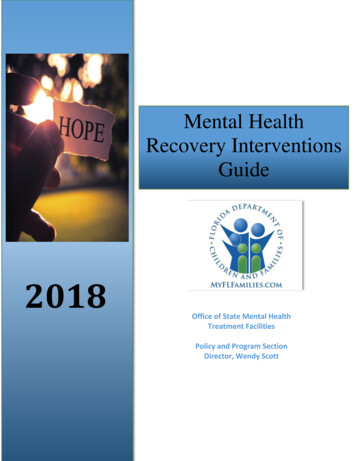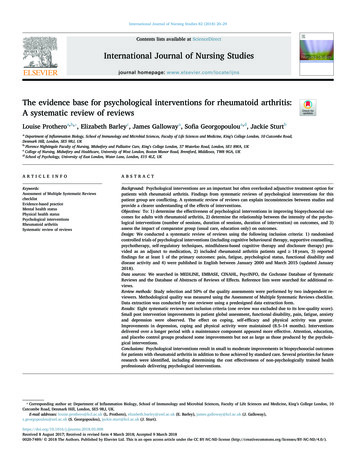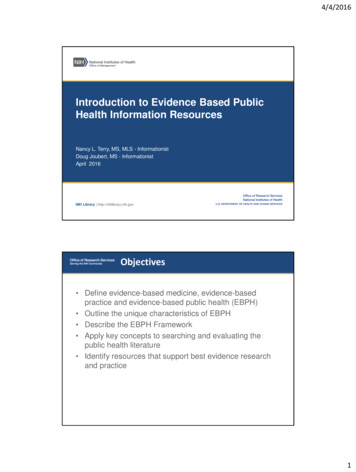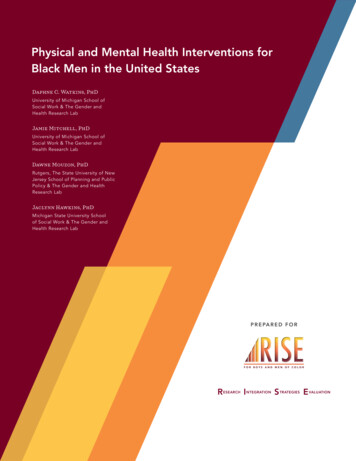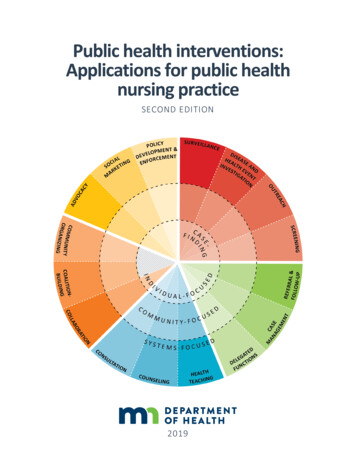
Transcription
Public health interventions:Applications for public healthnursing practiceSECOND EDITION2019
Public health interventions: Applications for public health nursing practiceSecond editionMarjorie Schaffer, PhD, RN, PHNSusan Strohschein, DNP, RN, PHN (retired)Suggested citation: Minnesota Department of Health. (2019). Public health interventions: Applications forpublic health nursing practice (2nd ed.).Minnesota Department of HealthCommunity Health DivisionPO Box 64975St. Paul, MN ealth.state.mn.usTo obtain this information in a different format, call: 651-201-3880.
ContentsAcknowledgements . 5Foreword. 7Introduction . 8Overview of evidence-based practice and related topics . 17Red wedge . 25Surveillance . 25Disease and health event investigation . 40Outreach. 53Screening . 65Case-finding . 78In review . 87Green wedge . 91Referral and follow-up . 91Case management . 104Delegated functions . 115In review . 128Blue wedge . 131Health teaching . 131Counseling . 142Consultation . 155In review . 165Orange wedge . 167Collaboration . 167Coalition-building . 181Community organizing . 193In review . 204Yellow wedge . 207Advocacy . 207Social marketing . 220Policy development and enforcement . 237In review . 248
This page left intentionally blank.
INTRODUCTIONAcknowledgementsThe 2019 evidence update of Public health interventions: Applications for publichealth nursing practice builds on the foundational work of Linda Olson Keller, DNP,RN, PHN, FAAN; Susan Strohschein, DNP, MS, RN, PHNA (retired); and Laurel Briske,MA, RN, CPNP (retired). Their visionary leadership brought together public health literature and the expert practice of public health nurses to make the InterventionWheel a reality for everyday public health nursing practice. The contributions of Dr.Keller and Dr. Strohschein in the dissemination of the Intervention Wheel create alegacy and responsibility for all public health nurses in intervening to improve population health.ReviewersWe are also grateful to our reviewers who read and critiqued drafts of individual intervention wedges. The reviewers asked good questions and made insightful comments, essential for revising this document for readability, clarity, accuracy, and applicability to public health nursing practice.With thanks, to the following reviewers:Linda J.W. Anderson, DNP, MPH, RN, PHNBethel UniversitySheryl Jacobson, MS, RNViterbo UniversityLinda Bauck-Todd, MS, RN, PHNMinnesota Department of HealthMaren Jensen, RN, PHNHennepin CountyKathleen Bell, EdD, RN, PHNSt. Catherine UniversityWendy Kvale, MS, MPH, PHNMinnesota Department of HealthAngela Bosshart, BSN, RN, PHNHennepin CountyJanelle Lambert, BSN, PHNMinnesota Department of HealthBonnie Brueshoff, DNP, RN, PHNDakota CountyKaren Jorgensen-Royce, MSN, RN, PHNWright CountyBethany Divakaran, DNP, MPH, RN, PHNConcordia UniversityKaren Loewenson, MA, RN, PHN, CNESt. Catherine UniversityKari Glavin, PhD, MSc, RN, PHNVID Specialized UniversityStacie O'Leary, MA, RN, PHN, LSNIndependent School District 197Karen S. Goedken, MSN, PHNHennepin CountyMary Orban, MA, PHNMinnesota Department of HealthPamela L. Guthman, DNP, RN-BCUniversity of Wisconsin-Eau ClairePatricia M. Schoon, DNP, MPH, RN, PHNMetropolitan State UniversityPUBLIC HEALTH INTERVENTIONS 5
INTRODUCTIONLinda Reveling Smith, MPH, RN, PHNWinona State UniversityJernell Walker, BSN RN, PHNHennepin CountyStephanie Rivery, DNP, RN, PHNDakota CountyCarol Wentworth, BSN, RN, PHNCarver CountyAmalia Roberts, DNP, RN, PHNDakota CountyMaureen Wosepka, MSN, RN, PHN, LSNSt. Catherine UniversityAnna Terry, MSN, RN, PHNDakota CountySusan Zahner, DrPH, RN, FAANUniversity of Wisconsin-MadisonProject staffJulia Ashley, MA, PHNMinnesota Department of HealthKristin Erickson, MSN, RN, APHN-BCMinnesota Department of HealthAllison Hawley March, MPHMinnesota Department of HealthReviewer notesI found the formatting and updated evidence cited in the chapters much more clearand applicable to current practice. I believe the evidence tips’ formatting makes thefull chapters for each intervention on the wheel a great deal more “readable” andeasier for everyone to grasp.***Overall, this is a very straightforward way for students and public health nursing professionals alike to refer to and know exactly what an intervention encompasses, aswell as ideas for implementing the intervention, and how to stay in the public healthnursing swim lane when working with other health care entities in the health caresystem and in communities.***I was very impressed with the comprehensiveness of the intervention definitions, applications, and evidence tips.***I appreciated using stories and application questions as appropriate triggers for discussion in my teaching practice.6 PUBLIC HEALTH INTERVENTIONS
INTRODUCTIONForewordPublic Health Interventions: Applications for Public Health Nursing Practice, firstpublished in 2001 and commonly known as the Public Health Intervention Wheel,guides the actions of public health nurses and their colleagues nationally and internationally across cultures and countries. During the past 18 years, practitioners haveused the Intervention Wheel framework to plan and evaluate practice, as well as respond to emergency preparedness, develop control measures for emerging contagious disease outbreaks, and promote lifestyle changes related to population healthimprovement.Significant growth of the evidence base of the 2001 manual and the correspondingdevelopment of evidence-based public health practice led to the need to publish asecond edition that reflects new evidence. Although the literature search is not exhaustive, we have used a systematic process to identify new evidence and revisit previous evidence. We hope this evidence update broadens the support for implementation of the 17 public health interventions. We realize that many expert public healthpractitioners hold a wealth of practice-based evidence that may not be reflected inthis update. We encourage you to share that evidence through presentations andpublication.We do not expect that every public health professional will be proficient in all interventions at all practice levels. Your role and your agency determines the range, frequency, and practice level of respective interventions. In a larger agency, practitioners may focus on one or two interventions across one practice level. In a smalleragency, practitioners may use multiple interventions across multiple practice levels.Wherever you practice, you may find that your actions encompass a variety of interventions based on a range of evidence levels.We hope this evidence update inspires you to grow your public health practice andsupport environments in which people can be healthy. In so doing each one of uscontributes to the vision of Lillian Wald, founder of American community nursing:The call to nurse is not only for the bedside care of the sick, but to help inseeking out the deep-lying basic cause of illness and misery, that in thefuture there may be less sickness to nurse and to cure. (Wald, 1915, p. 65)--Marjorie Schaffer, PhD, RN, PHN and Susan Strohschein, DNP, RN, PHN (retired)PUBLIC HEALTH INTERVENTIONS 7
INTRODUCTIONIntroductionPublic health interventions: Applications for public health nursing practice, 2nd editionBackgroundUnder the leadership of public health nurses, the Minnesota Department of Health(MDH) developed a manual, Public health interventions: Applications for publichealth nursing practice, to guide public health nursing practice. MDH distributed thismanual, commonly known as the Public Health Intervention Wheel, to public healthdepartments and public health nurses in 2001. Informed by literature and expertpractice, the Public Health Nursing Intervention Wheel framework provides a common language that names the work of public health nurses.Two articles published in 2004 provide details about the development and dissemination of the manual: Keller, L. O., Strohschein, S., Lia-Hoagberg, B., & Schaffer, M. A. (2004).Population-based public health interventions: Practice-based and evidencesupported (Part I). Public Health Nursing, 21(5), 453-468.Keller, L. O., Strohschein, S., Schaffer, M. A., & Lia-Hoagberg, B., (2004).Population-based public health interventions: Innovations in practice, teaching,and management (Part II). Public Health Nursing, 21(5), 469-487.Public health nurses in Minnesota, across the United States, and in other countries,including Australia, Ireland, and Norway, embrace and use the Public Health Intervention Wheel (Anderson et al., 2018; Baisch, 2012; Bigbee, 2012; Depke, 2011;Leahy-Warren, 2018; McDonald et al., 2015; Reilly, Collier, & Edelstein, 2011;Schaffer, Anderson, & Rising, 2016; Schaffer, Kalfoss, & Glavin, 2017).How has public health nursing practice changed?Since the 2001 dissemination of the Public Health Intervention Wheel, changes in thesocioeconomic and political landscape triggered changes in public health nursingpractice. Health care reform policy began to address social determinants of health,prevention, and population health in community settings (Swider, Berkowitz,Valentine-Maher, Zenk, & Bekemeier, 2017; Bekemeier, Zahner, Kulbok, Merrill, &Kub, 2016) driving public health practice to respond in like manner. In response tothe September 11, 2001 terrorist attacks and bioterrorism incidents, the U.S. federalgovernment provided substantial funding to state and local governments for emergency preparedness activities (Katz, Attal-Juncqua, & Fischer, 2017). This funding ledto including emergency preparedness activities and opportunities in public healthnursing practice.8 PUBLIC HEALTH INTERVENTIONS
INTRODUCTIONAt the same time, challenges to the public health infrastructure affected the availability of resources and support for public health nursing practice. These challengesinclude insufficient funding, resulting in budget cuts and loss of prevention and healthpromotion services; a declining public health workforce, including public healthnurses (PHNs); and workforce issues, such as non-competitive salaries, retirements,technology changes, lack of diversity, and lack of formal public health training(Bekemeier et al., 2016).In response to these events and challenges, public health nurses require increasedskills in system- and community-level interventions. Strengthening the public healthsystem and improving population health depends upon expertise in community engagement and partnership development (National Institutes of Health, 2011; RobertWood Johnson Foundation, 2017). Decreasing resources for public health work demand that public health nurses work efficiently and effectively. Using best evidenceto support interventions when collaborating with systems and communities improvespopulation health and reduces health care dollars spent on acute and crisis healthcare. This manual updates the best evidence for public health nursing interventionsand provides PHNs with the knowledge and tools to design and implement effectiveinterventions in their practice.How has the Public Health Intervention Wheelchanged?All of the interventions and the five Intervention Wheel wedges remain the same.The authors simplified the manual content, and updated and aligned interventiondefinitions with new evidence found in the literature. Each intervention includes thefollowing sections: DefinitionPractice-level examples (individual/family, community, or systems)Relationships to other interventionsBasic steps for the intervention with application exampleKey points from evidence (summarizes relevant evidence with evidence levels)Wheel notes (concerns, thoughts, challenges relevant to the intervention)Reference listA few things to keep in mind when using the manual: Practice-level examples related to each intervention facilitate distinguishing between practice levels.Real examples from the literature and/or public health nursing experience formthe basis of application examples related to the intervention basic steps.Key points from evidence include research and non-research (evidence that reflects expert practice in the public health field that has not come through a rigorous research process) evidence.A story with application questions at the end of each intervention wedge encourages consideration of the intervention and facilitates application of the intervention’s basic steps.PUBLIC HEALTH INTERVENTIONS 9
INTRODUCTIONMethodThe authors searched CINAHL (Cumulative Index to Nursing and Allied Health Literature) as the primary database for evidence updates on public health interventions from2000 to 2018. The name of the intervention combined with other terms, such as publichealth, public health nursing, intervention, community, and nursing narrowed thesearch. For some interventions, alternative terms yielded additional articles, such asthe use of health education for health teaching. Journals yielding a high number of articles addressing public health interventions included Public Health Nursing, the Journalof Community Health Nursing, the Journal of School Nursing, the American Journal ofPublic Health, and the Journal of Public Health Management and Practice.Searching government health-related websites and textbooks provided other sourcesof evidence. Government websites included the Centers for Disease Control and Prevention (CDC), the National Association of County and City Health Officials (NACCHO),the World Health Organization (WHO), the U.S. Department of Health and HumanServices, and state health departments. Classic textbooks on some of the interventions provided evidence for each intervention’s basic steps.The authors used the Johns Hopkins Nursing Evidence-Based Practice Model (Dang &Dearholt, 2018) to categorize evidence levels (for further explanation of evidencebased practice, see Overview of evidence-based practice and related topics, on p. 16).Although all five levels of evidence support basic steps and key evidence points forinterventions, lower levels of evidence predominate. Non-experimental studies provide the primary basis for research evidence for interventions.Public health nursing interventionsPublic health nurses work in or out of schools, homes, clinics, jails, shelters, mobilevans, and dog sleds. They work with communities, the individuals and families thatcompose communities, and the systems that affect the health of those communities.Regardless of where or with whom they work, all PHNs use a core set of interventionsto accomplish their goals.Interventions are actions that public health nurses take on behalf of individuals/families, communities, and systems, to improve or protect health status (Minnesota Department of Health, 2001, p. 1).This framework, known as the Intervention Wheel, defines the scope of public healthnursing practice by type of intervention and level of practice (individual/family, community, or systems), rather than by the site of service such as home, school, occupational health, clinic, and others. The Intervention Wheel describes the scope of practice by what is similar across settings and describes the practice of public health nursing at the individual/family, community, or systems level. The Intervention Wheel answers the question, “What do public health nurses do?” and delineates public healthnursing as a specialty practice of nursing. These interventions are not exclusive topublic health nursing, as they are also used by other public health disciplines, exceptfor delegated functions.10 PUBLIC HEALTH INTERVENTIONS
INTRODUCTIONThe Intervention Wheel:The “how” of public health nursing practiceThe Intervention Wheel integrates three distinct and equally important components:1.The population-basis of public health interventions2.Three levels of public health practice: Individual/family Community Systems3.Seventeen public health interventions: Surveillance Disease and health eventinvestigation Outreach Screening Case-finding Referral and follow-up Case management Delegated functions Health teaching ingCommunity organizingAdvocacySocial marketingPolicy development andenforcementPUBLIC HEALTH INTERVENTIONS 11
INTRODUCTIONThe Intervention Wheel consists of a colorful outside ring, three inner rings, and 17“wedges” or “slices.” All public health interventions are population-based. A population is a collection of individuals who have one or more personal or environmentalcharacteristics in common. A population of interest is a population that is essentiallyhealthy, but who could improve factors that promote or protect health. A populationat risk is a population with a common identified risk factor or risk exposure that posesa threat to health.Intervention wedgesThe interventions are grouped with related interventions; these “wedges” are colorcoordinated to make them more recognizable.Red wedge: Surveillance, disease and health event investigation, outreach, screening, case-finding. Surveillance is often paired with disease and health event investigation, even though either can be implemented independently. Screening frequentlyfollows either surveillance or disease and health event investigation and is often preceded by outreach activities in order to maximize the number of those at risk whoactually get screened. Most often, screening leads to case-finding, but this intervention can also be carried out independently or related directly to surveillance and disease and health event investigation.Green wedge: Referral and follow-up, case management, and delegated functionsare often implemented together.Blue wedge: Health teaching, counseling, and consultation are more similar thanthey are different. Often health teaching and counseling are paired.Orange wedge: Collaboration, coalition-building, and community organizing aregrouped together because they are all types of collective action and are often carriedout at the community or systems level of practice.Yellow wedge: Advocacy, social marketing, and policy development and enforcement are often interrelated when implemented. In fact, advocacy is often viewed asa precursor to policy development; and social marketing is seen by some as a methodof carrying out advocacy.Population-based interventionsThe Intervention Wheel is grounded in population-based practice. Interventions arepopulation-based if they address all of the following:1.2.3.4.5.An entire populationAn assessment of community healthBroad determinants of healthAll levels of preventionAll levels of practice12 PUBLIC HEALTH INTERVENTIONS
INTRODUCTION1. Public health interventions are population-based if they focuson entire populations possessing similar health concerns orcharacteristicsPopulation-based interventions are not limited to only those who seek service or whoare poor or otherwise vulnerable. Population-based planning always begins by identifying everyone in the population of interest or the population at risk. For example,it is a core public health function to assure that all children are immunized againstvaccine-preventable disease. Even though limited resources compel public health departments to target programs toward those children known to be at particular riskfor being under- or unimmunized, the public health system remains accountable forthe immunization status of the total population of children.2. Public health interventions are population-based if they areguided by an assessment of population health status determinedthrough a community health assessment processA population-based model of practice begins with a community health assessmentprocess. Public health analyzes health status (risk factors, problems, protective factors, assets) within populations; establishes priorities; and plans, implements, andevaluates public health programs and strategies. Public health agencies assess thehealth status of populations on an ongoing basis, so that public health programs respond appropriately to new and emerging problems, concerns, and opportunities.Since the 2010 passage of the Affordable Care Act (sometimes known as the ACA, thePatient Protection and Affordable Care Act, or Obamacare), nonprofit hospitals andhospital systems must also conduct community health needs assessments to maintain their federal tax-exempt status. This incentivizes local public health departments,hospital systems, and other community partners to collaborate on the communityhealth assessment process.3. Public health interventions are population-based if theyconsider the broad determinants of healthA population-based approach examines all factors that promote or prevent health. Itfocuses on the entire range of factors that determine health, rather than just personalhealth risks or disease. Examples of broad determinants of health include income andsocial status, race and ethnicity, housing, nutrition, employment and working conditions, social support networks, education, neighborhood safety and violence issues,physical environment, personal health practices and coping skills, cultural customsand values, and community capacity to support family and economic growth.4. Public health interventions are population-based if theyconsider all levels of prevention, with a preference for primarypreventionPrevention is anticipatory action taken to prevent the occurrence of an event (primary prevention) or to minimize its effect after it has occurred (secondary prevention). A population approach is different from the medical model in which personsseek treatment when they are ill or injured. Not every event is preventable, but everyPUBLIC HEALTH INTERVENTIONS 13
INTRODUCTIONevent does have a preventable component. A population-based approach presumesthat prevention may occur at any point. Primary prevention promotes health and protects against health threats. It isimplemented before a problem develops; it targets essentially well populations.Primary prevention promotes resiliency and protective factors or reduces susceptibility and exposure to risk factors. Examples of primary prevention includebuilding assets in youth and immunizing for vaccine-preventable diseases. In recent literature, this approach is often labeled an “upstream” approach, in whichthe focus of care modifies the social determinants of health with the goal ofpreventing disease and disability (Schoon, Porta, & Schaffer, 2019).Secondary prevention detects and treats problems in their early stages. It is implemented after a problem has begun, but before signs and symptoms appear.Secondary prevention keeps problems from causing serious or long-term effectsor from affecting other people. It identifies risks or hazards and modifies, removes, or treats them before a problem becomes more serious. It targets populations that have risk factors in common. An example is screening for homesafety and correcting hazards before an injury occurs.Tertiary prevention limits further negative effects from a problem. It is implemented after a disease or injury has occurred. Tertiary prevention alleviates theeffects of disease and injury and restores individuals to their optimal level offunctioning. It targets populations who have experienced disease or injury. Tertiary prevention keeps existing problems from getting worse—for instance, collaborating with health care providers to ensure periodic examinations, to prevent complications of diabetes such as blindness, renal disease failure, and limbamputation.Whenever possible, public health programs emphasize primary prevention.5. Public health interventions are population-based if theyconsider all levels of practiceThis concept is represented by the inner three rings of the Intervention Wheel; theinner rings of the wheel are labeled individual/family-focused, community-focused,and systems-focusedA population-based approach considers intervening at all possible levels of practice.Interventions may be directed at the entire population within a community, the systems that affect the health of those populations, and/or the individuals and familieswithin those populations known to be at risk. Population-based systems-focused practice changes organizations, policies,laws, and power structures. The focus is not directly on individuals and communities but on the systems that impact health. Changing systems is often a moreeffective and long-lasting way to impact population health than requiringchange from community norms or from every single individual in a community.Population-based community-focused practice changes community norms, attitudes, awareness, practices, and behaviors. It is directed toward entire populations within the community or occasionally toward specific groups withinthose populations. Community-focused practice is measured in terms of whatproportion of the population actually changes.14 PUBLIC HEALTH INTERVENTIONS
INTRODUCTION Population-based individual-focused practice changes knowledge, attitudes,beliefs, practices, and behaviors of individuals or families. This practice level isdirected at individuals, alone, or as members in a family or group. Individualsreceive services upon identification with a population at risk.Interventions at each of these levels of practice contribute to the goal of improvingpopulation health status. Public health professionals determine the most appropriatelevel(s) of practice based on community need and the availability of effective strategies and resources. No one level of practice is more important than another; in fact,population health issues are addressed at
The authors searched CINAHL (Cumulative Index to Nursing and Allied Health Litera-ture) as the primary database for evidence updates on public health interventions from 2000 to 2018. The name of the intervention combined with other terms, such as public health, public health nursing, intervention, community, and nursing narrowed the search.





